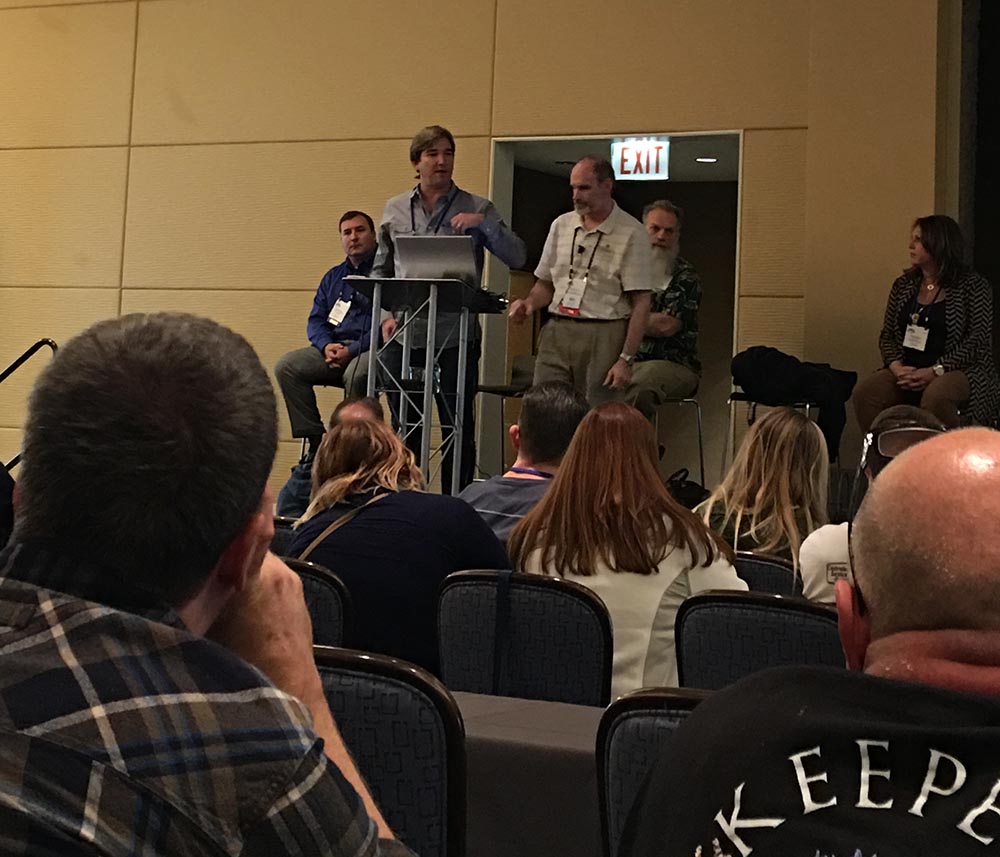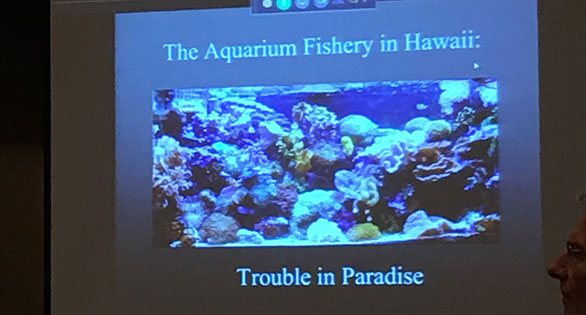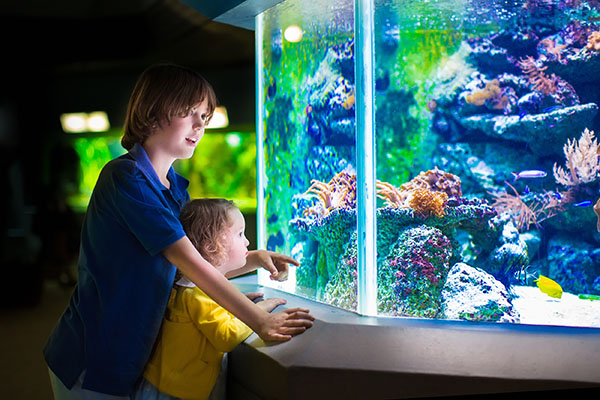
Quality Marine’s Chris Buerner addresses Town Hall attendees of the Aquatic Experience Chicago’s State of the Aquatic Industry Legislative Update held on Friday, November 3rd, 2017.
guest commentary by Laura “Peach” Reid,
Pet Industry Joint Advisory Council (PIJAC)
“Without standing together, there is real potential for an end to the era of aquariums….”
For the last five years, activist groups have pressed a full-court attack against ornamental fishing professionals, hobbyists, and aquarium advocates.

Laura “Peach” Reid, PIJAC Board Chair
They finally got their way earlier this year when the Hawaii Supreme Court ruled that state’s Department of Land and Natural Resources (DLNR) was subject to the Hawaii Environmental Policy Act (HEPA) when issuing fine mesh licenses.
This has the potential to shut down the industry in Hawaii. The Pet Industry Joint Advisory Council (PIJAC), for which I serve as Chair of the Board of Directors, has joined state fishers to attempt an overturning of the decision. We are also working with DLNR to conduct an environmental impact study.
These efforts are certain to cost well over $200,000. And that doesn’t count PIJAC’s work to stop extremists in states such as Michigan, Maine, and Florida, as well as internationally.
Serious Threats to Keeping a Fish
Ninety-three percent of the world’s Yellow Tangs found in aquariums come from Hawaii. This is at risk thanks to Umberger’s and Earth Justice’s lawsuit, and the Hawaii court’s decision. These radicals won’t stop there; from the guppies and tetras, to butterflyfish and tangs, they oppose keeping any fish in any aquarium. They’re not slowing down, either—the number of proposed aquatics-related laws has increased dramatically in recent years.
We need to come together. And we need to do it fast. I’m optimistic after watching so many hobbyists, retailers, aquatic leaders, and marine experts come together at the Aquatic Experience Legislative Update on November 3.
At this town hall-style event, which was hosted and moderated by PIJAC’s Robert Likins, the implications of bad science were examined. Andrew Rhyne, Ph.D., an expert in marine biology, described a study he is conducting that questions the legitimacy of the accepted method for detecting the use of cyanide in marine fishing collection. Attorney Jim Lynch explained the implications of the Hawaii fight. Other critical issues took the limelight in a way rarely seen in our industry.

The Aquarium Fishery in Hawaii – Trouble in Paradise. A presentation shown at the recent State of the Aquatic Industry Legislative Update at the 2017 Aquatic Experience Chicago.
Joining the Battle
The response has been tremendous. My company donated $5,000 to further PIJAC’s efforts on behalf of the industry. At least $45,000 more was donated by the breadth of aquatic professionals – such as manufacturers, retailers, importers, distributors, and hobbyists.
But one event won’t halt activists’ momentum. We all must step up to the plate and donate our time, money, and other resources to win these battles. The exorbitant cost of fighting to ensure the future of aquarium fishing is clear—but the cost of standing by silently is even greater. Without standing together, there is real potential for an end to the era of aquariums.
The time has come; the momentum for anti-aquarium activists is at a tipping point. Those at Aquatic Experience Chicago seemed to grasp the seriousness of the situation. We now need everyone to do their part. CORAL and AMAZONAS Magazines will use their influence to spread the word to its subscribers, social media followers, the trade, and others. I work directly with PIJAC, and I encourage everyone to donate, join, or both.
What will you do?

Worth saving for future generations: “Without standing together, there is real potential for an end to the era of aquariums.”
Join & Donate
Click here to become a member of PIJAC.
Click here to donate to the Aquatics Defense Fund.
Contact
You can reach individual PIJAC leaders at https://pijac.org/contact-us
Further Reading
Search Reef2Rainforest.com for “Hawaii Fishery” to find past CORAL articles and online coverage of the ongoing fight over the marine aquarium fishery in Hawaii.
A search of CORALmagazine.com for “Endangered Banggai” will reveal a multitude of articles covering the plight of this iconic marine fish as government and international organizations struggle to determine the species status and future.
Stay up to date with current information on PIJAC’s Aquatic Issues homepage.
The Author
Laura “Peach” Reid is the CEO of Fish Mart and Chair of the Board of Directors for the Pet Industry Joint Advisory Council.





Laura “Peach” Reid should get her facts straight. Her statement, “These radicals won’t stop there; from the guppies and tetras, to butterflyfish and tangs, they oppose keeping any fish in any aquarium,” is patently false.
It’s a scare tactic designed to solicit donations so they can, ultimately, protect the bottom line of the trade that considers fish and other wildlife as expendable livestock necessary to drive the lucrative sales of equipment, supplies and fish food (paraphrased statement from Bob Fenner).
In fact, we are ONLY opposed to keeping marine life that has been captured in the wild OR aquacultured marine life that is unsuitable for the average hobbyist (e.g. batfish). Our award-winning educational mobile app, Tank Watch, teaches hobbyists which species are likely aquacultured vs. those which are definitely wild. One need visit our website for just ten seconds before a pop-up for Tank Watch appears on the screen.
Someone has misinformed “Peach”.
As for the court case: the State of Hawaii has failed in it’s duty to ensure the capture/sale of marine life for aquariums does not negatively impact these species. DLNR was first informed of the need to comply with Hawaii’s environmental law in the late 1970’s. They ignored it. They were again informed in 2012 and in 2015, and, again, they ignored it. Their extreme arrogance and refusal to comply has led to this shut down by the Supreme Court. Had they initiated this assessment years ago, without being forced to by the high court, it may have been completed by now.
If populations of Hawaii’s yellow tangs were depleted by just 5% or 10% in the areas where they are taken, Hawaii residents would not be up in arms over this. It’s the 90% decline on Oahu and the 65% decline in West Hawaii/Kona that residents aim to change.
“Mister” Umberger is crazy pants.
“Laura “Peach” Reid should get her facts straight. Her statement, “These radicals won’t stop there; from the guppies and tetras, to butterflyfish and tangs, they oppose keeping any fish in any aquarium,” is patently false.” Patently false? Documentation please?
“It’s a scare tactic designed to solicit donations so they can, ultimately, protect the bottom line of the trade that considers fish and other wildlife as expendable livestock necessary to drive the lucrative sales of equipment, supplies and fish food” Crazy pants given that “Rene” is the queen of scare tactics
” (paraphrased statement from Bob Fenner).” Oh, just stop this crap. Stop paraphrasing and taking people out of context. It is intentionally misleading.
“In fact, we are ONLY opposed to keeping marine life that has been captured in the wild OR aquacultured marine life that is unsuitable for the average hobbyist (e.g. batfish).”
No you aren’t. You and your buddies are on record in many places saying that keeping fish in tanks is like jail and it should be completely stopped.
“Our award-winning educational mobile app, Tank Watch, teaches hobbyists which species are likely aquacultured vs. those which are definitely wild. One need visit our website for just ten seconds before a pop-up for Tank Watch appears on the screen.” Tank watch is crap, with bad information.
“Someone has misinformed “Peach”.” Yes, you. You continue to make up stuff about the situation while ignoring actual data.
“As for the court case: the State of Hawaii has failed in it’s duty to ensure the capture/sale of marine life for aquariums does not negatively impact these species. DLNR was first informed of the need to comply with Hawaii’s environmental law in the late 1970’s. They ignored it. They were again informed in 2012 and in 2015, and, again, they ignored it. Their extreme arrogance and refusal to comply has led to this shut down by the Supreme Court. Had they initiated this assessment years ago, without being forced to by the high court, it may have been completed by now.” What a bunch of hooey.
“If populations of Hawaii’s yellow tangs were depleted by just 5% or 10% in the areas where they are taken, Hawaii residents would not be up in arms over this. It’s the 90% decline on Oahu and the 65% decline in West Hawaii/Kona that residents aim to change.”
More lies and ignoring of actual studies.
You are laughable. You might win this because you are good at lying and misleading people, and if you do win, but you are a joke.
As I’m cited/”paraphrased” by Ms. Umberger here, I’d like to have whatever statement shown in full, w/in context. Plus I’d like to see the source of her assertions re declines of stocks she refers to for O’ahu and Kona. I DO dispute that the ornamental trade has had significant negative impact on shallow reef populations; and that pollution, native fishers are of far more consequence. Further, that the tropical fish industry not only provides a source of reasonable income to collectors in Hawaii, but the fishery is and has been proved by decades of sampling/study to be entirely sustainable. There is NOWHERE on our planet that the ornamental trade, native fishes have been as well studied and scrutinized. I ask that any person interested take the time to review pertinent fisheries works (by the Hawaiian DLNR and others) re this issue.
And this 90% decline you keep talking about – for years – has no support. It is a number you pulled out of thin air. Ugh.
The trop industry here on the Big Island has been sustainable and strongly inforced since the 70’s. The main reason
Beside research is that we have about 80 tour dive boats go out every day and the original closed areas were
The places thoze tourist boats dived. Now over 50 % of the west coast of the BI is a protected or a fish replenishment
Area FRA.
DONT BELIEVE ME. Go online and look up the studies both the DLNR And UH Hawaii. Have done. Perhaps
Its easier to form an opinion without the fact?
Lets all work together.
Aloha
Dan
PS. I have dived the west side for 20 years and have seen no decline in fish untill we had very bad el nino’s here
Sharing past comment on Rene; From Tina Owens executive director of the LOST FISH Coalition, Member West Hawaii Fisheries Council says:
A great deal of the “sky is falling” news you’ve heard about the reef recently is just plain not true.
Try giving credit to the thousands of volunteer hours given by your neighbors to the West Hawaii Fisheries Council to get the gains you are now free to enjoy. (done with the help of Aquarium Fishermen on the council who agreed to the laws)
Lost Fish Coalition, through the venue of the West Hawaii Fisheries Council, has been working with many stakeholders to get a reasonable settlement to the long-standing problem of the aquarium industry harvest. In almost 16 years, we have accomplished the following management actions:
• We have 55-plus miles of coastline where reef fish cannot be taken. These areas allow the fish to grow large enough to be very successful breeders. These areas — Fish Replenishment Areas — are the nurseries for the reef fish to spread out to the rest of the reefs.
Thanks to these measures, West Hawaii has more fish than most every other widely accessed reef in the state, especially the beautiful ornamentals that give tourists and residents so much delight. If someone says that nothing has been done in West Hawaii, they are either lying, unaware or are being duped by someone else’s lies about the situation. There are a few “outsiders,” by which I mean people who don’t live here, who have decided that West Hawaii doesn’t know what it’s doing. This group, headed by Maui resident Robert Wintner, and Wintner’s frontman Rene Umberger, decided it was going to be the ones to get aquarium collecting banned, to make themselves the “rescuers of the reef.”
Clearly if the goal is to get rid of the industry and management prevents that goal being reached, then discrediting the benefits and successes of management would seem the only way left to go. And so they have taken that path.
They have held community meetings and displayed a lot of false or twisted data, quoting from papers outdated by more than 15 years, and “re-interpreting” data from scientific papers. They have been telling people that “there are no fish left,” which is patently untrue. I once had a woman tell me with great passion and assurance that there are no fish left anywhere in West Hawaii. I asked her why she thought that, and she replied that everyone knew it. I asked if she swam in the ocean. No. Did she dive? No. Did she know anything about the management strategies in place? No. She had, however, just come from an “information session” in which she heard these things from Wintner’s frontman Rene Umberger.
Which brings me back to the wide-screen TV. The TV runs a 90-minute loop of undisturbed, natural activity of fish on the reef. Apparently, the footage was filmed on West Hawaii reefs. The article states: “Wintner praised the videos. ‘It shows what abundance looks like,’ Wintner said.”
At least he got that right.
~ Tina Owens, executive director of the LOST FISH Coalition, Member West Hawaii Fisheries Council and resident of Kailua-Kona.
Rene and Snorkel Bob are radicals and habitually dishonest. Every year they rely on misrepresentation of data and outright distortion of sound science. The fishery in West Hawaii is 100% sustainable and this has been verified through long term studies that have been submitted to the legislature every few years as required by law. The facts are, that in west Hawaii the adult yellow tang population is at capacity in the open and closed areas. This means that the habitat cannot sustain a larger population. This also means that West Hawaii is achieving the maximum as far as spawning capacity. What Rene, Bob and their little minions actuallly are is radical environmentalists. Most of them are vegan anti resource extraction of any kind, and would be considered fringe with the views they believe in. They have publically stated that they don’t want management, they want bans. There is no meeting in the middle with this group. And they will say whatever it takes to get what they want. The end, justifies the means.
Rene if you want to have a fact based debate, let’s have that. If you want to carry on with your morality and feelings argument then don’t bother. Look around, you have not one legitimate scientist or institution on your side. You don’t have one peer reviewed research paper to support your anecdote. Yet on our side we have all of that and then some.
Dan-
El Niño has increased the fish populations by extending the spawning season. This has now been studied and peer reviewed in a paper published by William Walsh and Brian Tissot. I can personally attest to these findings to be accurate.
Bob Fenner’s discussion of excessive wildlife loss in the marine aquarium trade and defense of it because it drives purchases of lucrative dry-goods:
“(It is my estimate that even given sustainable (hand-netting with or without pokers, barrier nets, traps…) collection practices, less than half of collected organisms live to be shipped from their mother-lands. Of those still living, an average fifth are lost in transit to the consignee, another fifth are lost within forty-eight hours of arrival, with a further two-fifth’s dying within a month. Yes, this leaves some ten percent of what was originally caught or approximately a fifth of those shipped. Virtually none (<1%) live more than a year in captivity.
Are these losses excessive? Economically no. The wet-pet livestock industry in the U.S. last year generated retail sales of about six hundred million dollars, of which seventeen percent were marine (International Marine Life Alliance Canada News Release). Most retailers hope to break even on sales of marine-life itself; the livestock are necessary though to drive purchases of lucrative dry-goods.
The moral question of whether the capture and keeping of marines is ethical is one we must ask ourselves or stand-by and let governments decide for us."
http://www.wetwebmedia.com/AqBizSubWebIndex/marlifeuse.htm
In 2003 Tissot and Hallacher published a peer-reviewed paper documenting "the magnitude of the effect of aquarium collecting on natural populations." To do so, they "compared differences in fish abundance along visual belt transects between collection sites, where collecting was known to occur, and control sites, where collecting was prohibited."
"Seven of the 10 fishes targeted by the aquarium trade were significantly lower in abundance in areas subjected to collecting than in areas where collecting was prohibited. The magnitude of these differences ranged from -38% to -75%." They concluded "that aquarium collectors have significant effects on the abundance of targeted fishes on the Kona coast of Hawaii."
http://onlinelibrary.wiley.com/doi/10.1111/j.1523-1739.2003.00379.x/abstract
Since then, year after year, data published by the state shows the same pattern of significant aquarium trade impact along the Kona coastline. Increases of fish abundance in the areas closed to aquarium take in 2000 prove the point that the aquarium trade is the cause of the significant declines in the areas open to the trade.
Again, a selective citation… the piece concludes:
“Other Sources of Mortality:
In any fair discussion of a subject there is a need to identify other contributing influences. In this case, alternate uses and causes of loss of life.
Wouldn’t it be great to elucidate all the inputs and outputs of “natural” causes in a model of recruitment and loss in these habitats? Let’s focus on those of solely human origin:
Development: has proven historically to be a huge negative influence. Unconscientious grading and drainage alone have smothered vast coastal marine areas, ostensibly wiping out all macro-life diversity for long periods of time.
Food-Gathering: with modern gear and techniques have had
documented disastrous results; e.g. the North Pacific sardine fishery, and diminishing mesh size on gill nets in Africa’s great lakes. Modern technology must be matched with prudence to obtain and maintain optimum sustainable yields.
Military: At present humans collectively expend about a quarter of their countries Gross Domestic Products on “defense”. The United States stated military budget is some two hundred eighty nine (289) billion dollars in 1993 (Business Week Feb. 14, 1994, p.8), more than the next ten countries outlays combined. Much of the consequent materials, waste oil, diesel, nuclear, aircraft fuel, CFC’s… ends up in marine environments. Why are we allocating so much resource to killing each other and the planet?
Tourism: Eco- or otherwise plays havoc with the same niches; amateur divers, fishers, their boats’ anchors, fuel and noise, the “business of life” which is human consumption, all contribute to wear and tear of natural resources.
These sources of mortality are exceedingly more detrimental and indiscriminate than collecting “pet-fish”. So all this being said and written; even though the collection, transport and keeping of captive marine organisms apparently accounts for comparatively minuscule loss of life and habitat damage, why the current interest in regulating such trade? Maybe it’s a possible new source of “revenue enhancement” (i.e. tax), perhaps a bureaucratic job scramble, maybe a smoke-screen? How are you going to generate funds from individuals and groups without such sensationalism? How much money are you going to make attacking the tourist industries or government sources of waste and inefficiency? But back to the central issue, is marine pet-fishing worth the cost to the environment?
Final Opinion:
Oh Dear Reader, I must side with the not-so-vocal majority in stating that I do think and feel the price is indeed small compared with the very real tangible benefits: Hard currency income for native peoples, the science and art that come from trying to keep a slice of the ocean. The algebraic growth in interest and awareness, appreciation for the grandeur which is the living world, & consequent protective conscience such husbandry has engendered. Yes, it’s worth it.”
Further this work dates from the early 1990’s, and there has been enormous improvement in collection, holding, shipping knowledge and techniques; with resultant improvement in survivability. Indeed, likely more than 10% of fish livestock is now aquacultured, and significantly more “corals” asexually produced for the ornamental trade.
One last (for now) comment re the figures presented for mortality: There is actually greater loss in the wild than that stated for captives here. The turnover, recruitment for aquatic life is very high indeed. Take a close read of fisheries, aquatic ecosystems reference works and you will find this to be so. Ms. Umberger would do well to study and stay quiet until she knows what she’s talking about.
How come no one has said anything about the miles of reef damaged by snorkel bobs sunscreen he sells
All these years. Now proven to kill corals ?
What a bunch of idiots. They have to have some reason for being, so they pick this “easy” target. I don’t hear them trying to regulate or stop the food fishing industry, which catches an enormous number of fishes every day (ever been to a fish market?). I guess they know they would get their asses kicked big time on that one. So, go after something they think won’t fight back too hard. How many of them have stood on the boats that challenge fishermen, or whale hunters? They would probably dirty their pants, so don’t expect to see these flower children doing anything like that. Pick a “soft target” to attack. Just like all terrorists, they are cowards, and prefer a target that won’t hit back too hard.
I would agree that like all lobbyists PIJAC is using scare tactics but would also agree that in the US there are probably organizations that would like to see the end of this hobby. However, those are fringe organizations. The Hawaii ban is very unlikely to stand, especially in the current era of “conservation” attitudes. Very likely if the case hits the federal courts it will be overturned…
It would be much easier to support the PIJAC if they were not also involved in many disgusting activities including supporting abusive pet stores such as Petco and Petsmart which largely treat all live animals like expendable goods. From a PR standpoint those two large sellers are a nightmare for our hobby as anyone can use the horrible conditions particularly of saltwater fish in those stores as an exhibit A to support almost any ban. The group also lobbies against reasonable restrictions on sales of dogs and cats in pet stores which is well known to fuel puppy mills and cause other pet overpopulation and health issues. Perhaps it’s time to have a separate lobbying group for reasonable collection of marine life for the reefing hobby. After all PIJAC is lobbying on behalf of the largest corporations not us hobbyists even when it may appear that our interests coincide…
I would however caution all those who think that throwing support to this organization is a good idea to research some of their other activities. It is unlikely that having such an entity supporting us will swing public opinion and support in our favor…